Source: Greenbiz
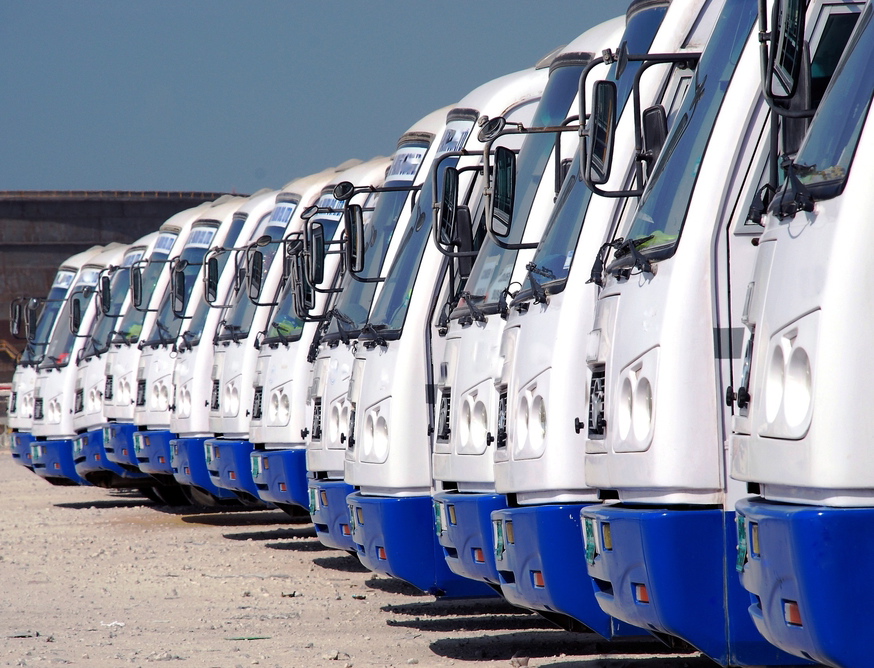
However you look at it, 2020 is a turning point for fleets.
Thanks to converging forces — including supportive policies, dropping battery costs and aggressive climate goals — transportation leaders at large and small organizations are increasingly turning to new zero-emission and low-carbon options that decarbonize fleets and in some cases save money.
Fleets are often the workhorses that toil behind the scenes: the garbage trucks that pick up your trash before dawn; the long-haul semi-trucks that move goods from the port; the bucket trucks that utilities use to fix power lines and keep your lights on; the delivery vans that drop off your packages and help you stay safe inside your homes.
The definition of fleet is evolving. Ride-hailing companies such as Lyft own vehicles, but they’re also working to help drivers that own their own vehicles move into EVs. The young e-scooter companies also own large “fleets,” although not in the traditional sense.
Fleet leaders are also facing increasing pressure. Policies such as California’s Advanced Clean Truck rule are forcing organizations in the state to phase in zero-emission trucks and phase out fossil fuel-based ones. Progressive cities, many in Europe, are building zones in downtown centers that are banning fossil-fuel vehicles and incentivizing zero-emission models. A global company that wants to deliver goods to residents in cities such as London, Paris, Madrid and soon Santa Monica, California, will need zero-emission vehicle (ZEV) fleets or it will lose business.
ZEVs are also an opportunity for fleets. Certain types of vehicles — including transit and school buses, delivery vans and light-duty cars — can save fleet owners considerable money when they’re switched to electric. Other types of fleets such as long-haul trucks will take a lot& longer to go electric.
One of the biggest concerns for fleet leaders is how to design, plan, deploy and manage the complicated infrastructure that sometimes can be required to charge or fuel various types of fleets. Investments in software and data, as well as building deep relationships with utilities, will be key to helping fleets navigate this daunting ecosystem.
Another chief concern is a lack of electric medium- and heavy-duty vehicle models from major OEMs in the U.S. that fit fleets’ needs. Time and again, fleet leaders say there just aren’t enough ZEV vehicles available for them to buy, and the ones that are available are just too expensive without incentives right now.
The pandemic has created unique challenges for fleets, including safety concerns for drivers, additional vehicle cleaning costs and the need to redesign operations around social distancing measures.
But the pandemic also has shone a spotlight on just how important many of these fleets are — in midst of the most aggressive lockdowns, trucks were running lifesaving groceries and personal protective equipment to communities and hospitals across the U.S.
So here’s our list, in alphabetical order, of 25 organizations taking important steps to decarbonize their fleets, buying (or planning to buy) new zero-emission vehicles and making the still-difficult choice to be an early adopter. The list includes public agencies, big corporations, small companies, school districts, utilities — it runs the gamut.
To hear from some of these fleet leaders — including Seattle’s Philip Saunders, Port Authority NY and NJ’s Christine Weydig, Anheuser-Busch’s Angie Slaughter, Walmart’s Zach Freeze, Amazon’s Ross Rachey, IKEA’s Angela Hultberg, FedEx’s Russ Musgrove, Genentech’s Andy Jefferson and Lime’s Andrew Savage — tune into VERGE 20 across the next five days. The keynotes are free, but you’ll need to buy a pass for the transportation deep-dive sessions.
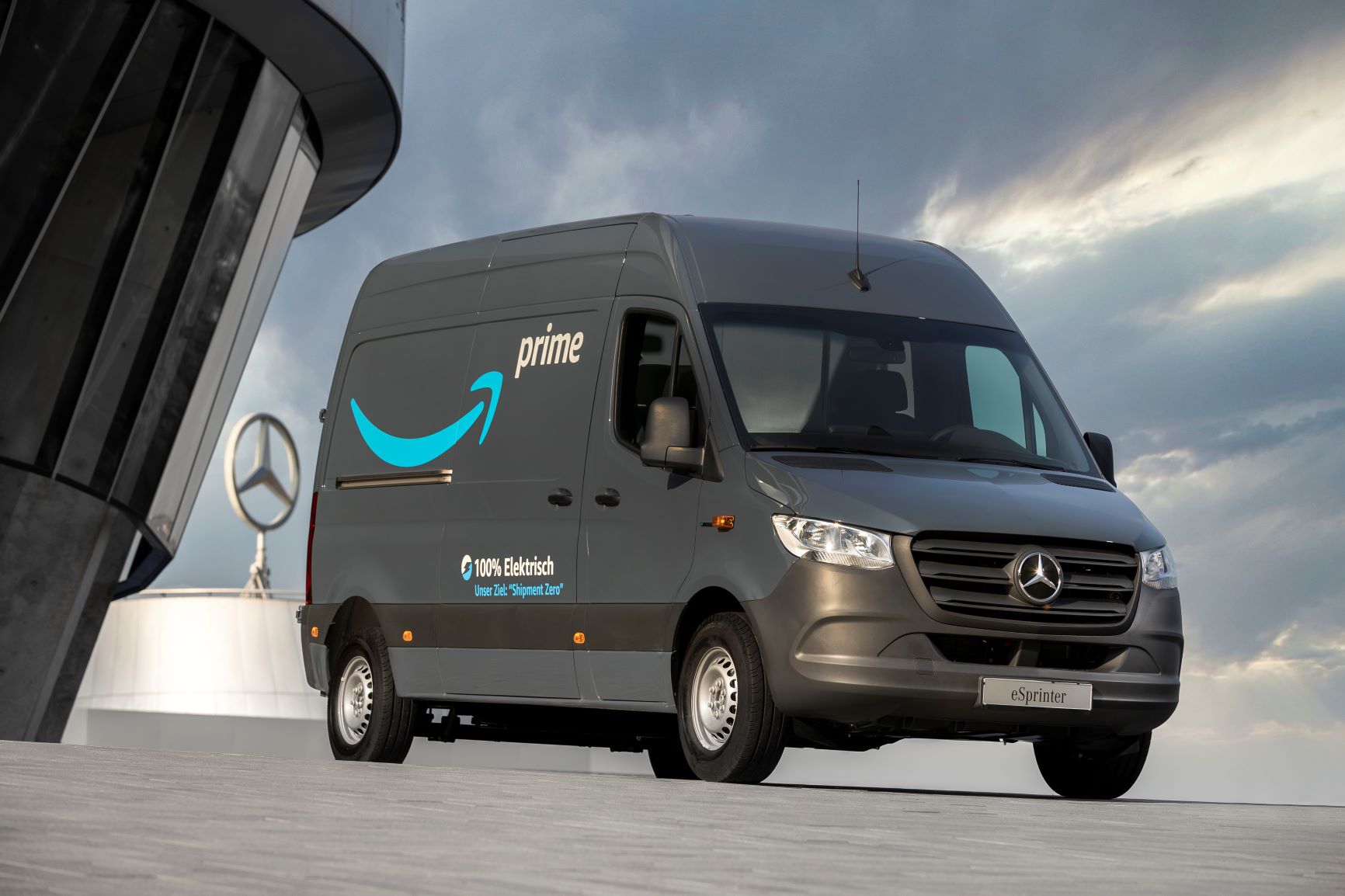
Amazon
Amazon’s domination of commerce and delivery means it’s got a lot of emissions from the vehicles that deliver orders to our doorsteps every day. But in early 2019, Amazon announced an industry-first for a delivery company: It pledged that half of all of its shipments would be net-zero carbon by 2030. The entire company (including transportation) will be net-zero carbon by 2040.
In true Amazon form, the company has written its own vehicle playbook and disrupted the status quo. While many fleet managers are challenged to find vehicles available that they can buy, Amazon routed around that problem by investing in — and planning to buy — 100,000 electric trucks from startup Rivian. Will Rivian eventually be a division of Amazon? Maybe: It would make sense for Amazon to bring vehicle production in-house in its constant bid for vertical integration.
But Amazon is also buying electric versions of the Mercedes-Benz sprinter van that dominates delivery markets. For now, we’re eagerly watching and waiting for more details about Amazon’s growing zero-emission and low-carbon vehicle fleet.

Anheuser-Busch
Beer giant Anheuser-Busch, the U.S. subsidiary of AB InBev, delivers about a million shipments of its beer per year, largely in trucks carrying beers such as Budweiser and Stella Artois to grocery stores and bars around the U.S. Of course, all that trucking delivers a big greenhouse gas footprint: 10 percent of Anheuser-Busch’s carbon emissions come from transportation.
But the beverage maker has a big sustainability plan and is taking a first-mover approach to decarbonizing its dedicated fleet of around 1,600 vehicles. The company has an order to buy up to 800 of Nikola Motor’s hydrogen-powered fuel cell trucks and 40 Tesla Semi trucks. It could be one of the first fleets in the country to get long-haul zero-emission vehicles, and it has a plan to convert its entire long-haul dedicated fleet to ZEVs by 2025. At the same time, it’s already adopting renewable natural gas to power its natural gas trucks in its short-haul fleet.
Overall, Anheuser-Busch has a goal to slash carbon emissions by a quarter across its entire supply chain by 2025. Just a short five years away.

Antelope Valley Transit Authority
This summer, the Antelope Valley Transit Authority (AVTA) — a transit organization that serves the Southern California cities of Lancaster and Palmdale — hit a milestone: 3 million miles of zero-emission bus operation. The group’s fleet consists of 93 buses, 61 of which are zero-emission buses, and the majority of those are BYD-made electric models.
The transit authority was one of the first in the U.S. to make a major commitment to electric buses four years ago, partly thanks to its close proximity to the American headquarters of BYD in Lancaster. A former BYD exec even joined AVTA as its CEO and has helped lead the e-bus transition.
AVTA says in addition to slashed carbon emissions and local air pollution, it’s been able to save 769,231 gallons of diesel fuel, the equivalent of more than $1 million in fuel cost savings.

Denver International Airport
If you’ve ever flown through Denver’s International Airport, you know the city prides itself on its innovative design and customer-friendly amenities. But it’s also been aggressively adopting zero- and low-emission vehicles.
Our friends at 100 Best Fleetsnamed Denver International Airport the second greenest fleet in America. It’s got close to 300 alternative-fueled vehicles, including electric, hybrid and natural gas buses, sweepers and light-duty vehicles. The airport also incentivizes hybrid taxis and vans by reducing their access fees to the airport.
Airport shuttle buses are a key area where electric vehicles will be able to make a dent, given their dedicated and short routes. States such as California are mandating that its 13 largest airports move their shuttle buses to zero-emission operations by 2035.

Facebook might not be thought of as a fleet leader, but two years ago Facebook acquired 43 BYD-made electric on-campus shuttles that can carry employees across its sprawling complex. At the time, the social media giant leveraged a unique financing deal led by Generate Capital to lease the vehicles, lowering the upfront costs.
Facebook says it’s investigating how it can electrify its commuter shuttle buses. Facebook started testing out a double-decker electric commuter shuttle bus last year and had planned to test more out this year. However, the pandemic and remote work has thrown a wrench into many companies’ commuter ZEV bus plans.
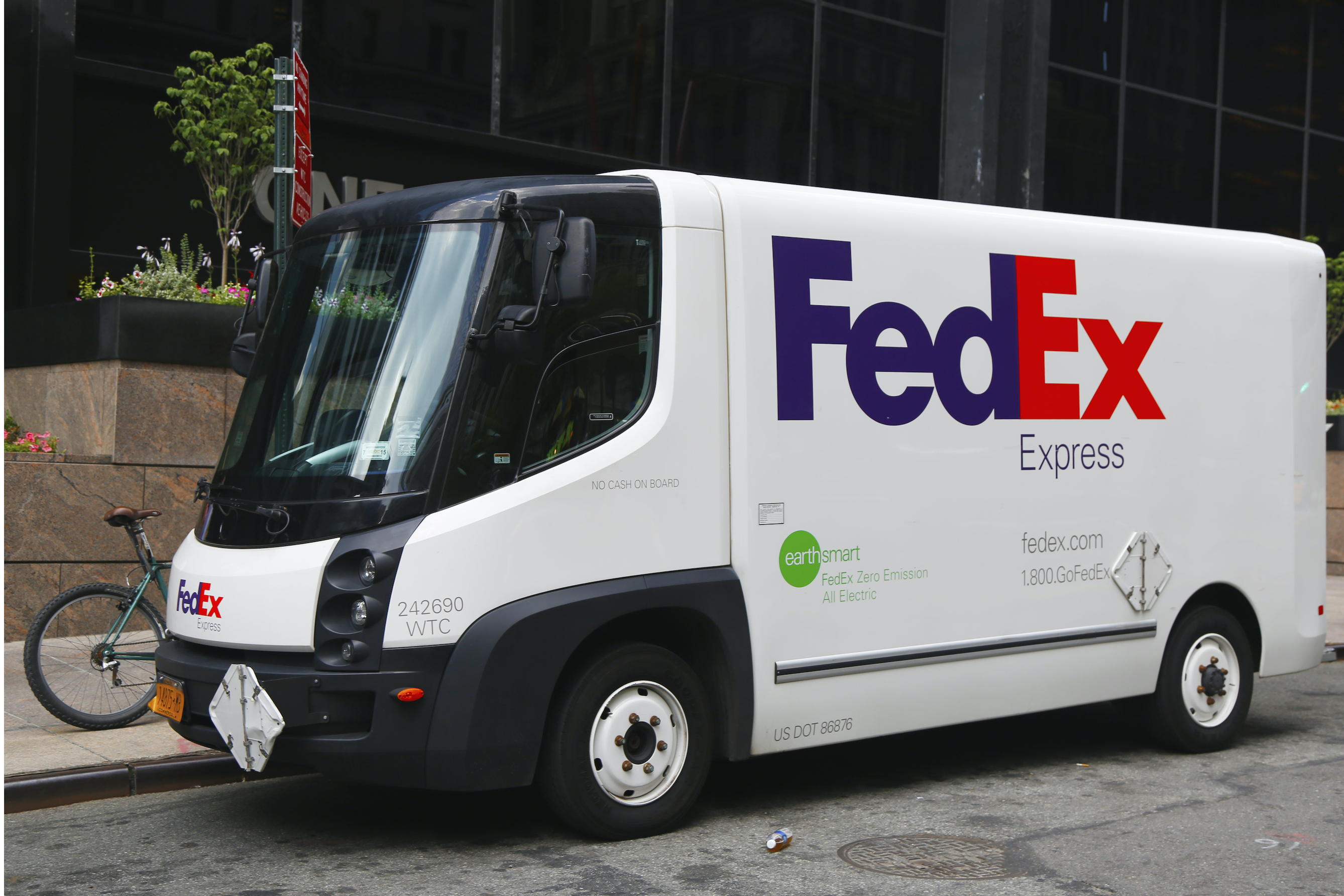
FedEx
Delivery trucks are a key type of vehicle ready for electrification. Bloomberg New Energy Finance earlier this year declared delivery trucks to be the “next segment to cross the tipping point” and an electric “killer app.”
FedEx, which has more than 100,000 vehicles in its Express division across the world, has been working on its zero-emission and low-carbon vehicle program for a couple of years. Two years ago, FedEx announced a partnership with startup Chanje to add 1,000 Chanje electric delivery vehicles to its fleet: 100 bought outright and 900 leased through Ryder. Chanje is also supplying FedEx with EV charging infrastructure
FedEx recently told the New York Times that it added close to 400 electric vehicles in its fleet internationally last year, which brought its total EVs to close to 3,000, including forklifts and airport ground service equipment.
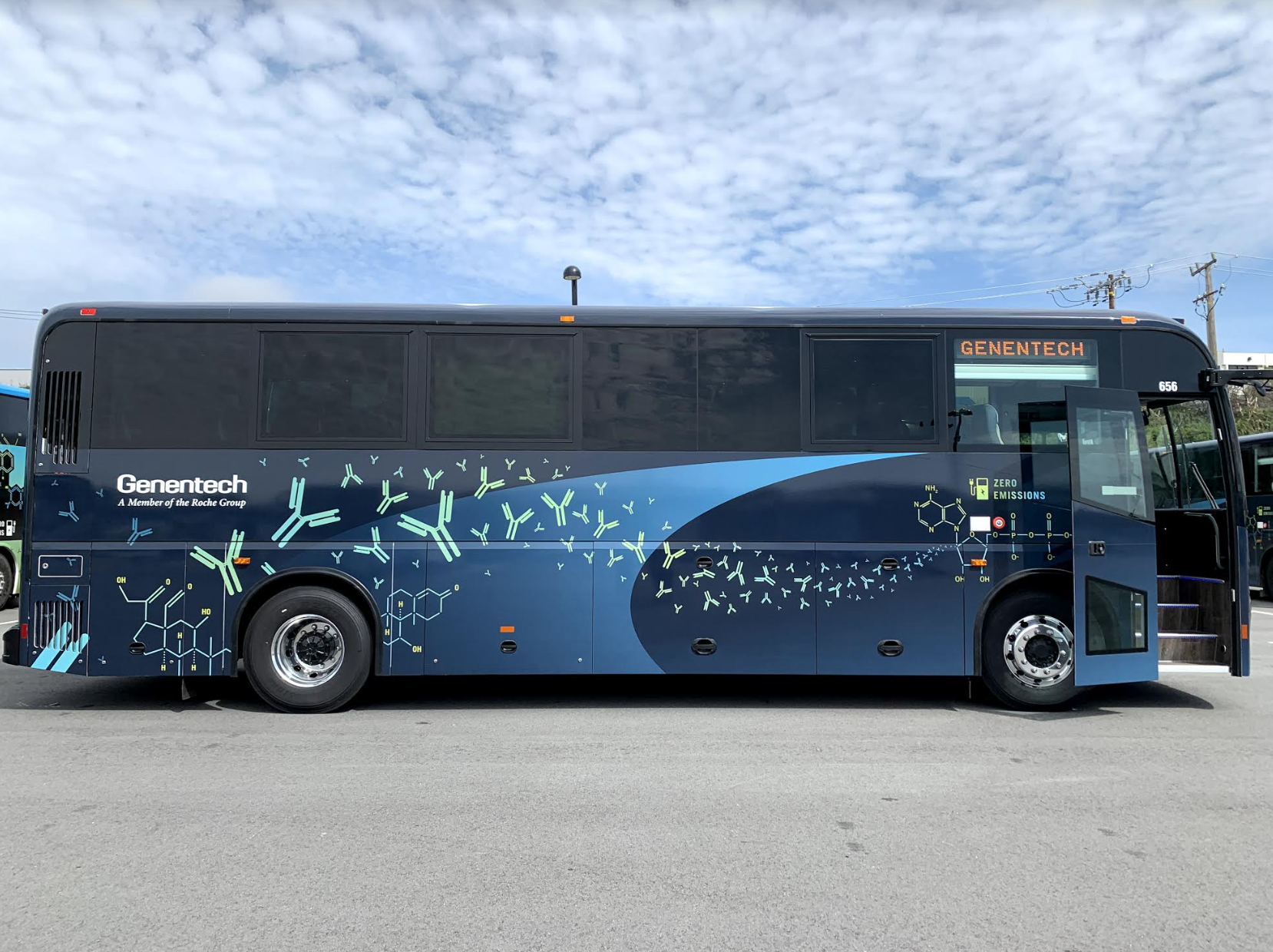
Genentech
Biotech giant Genentech is a surprising fleet leader: It’s got the most aggressive electric commuter bus programs around, in addition to its other EV fleet goals.
Two years ago, the company started running electric BYD-made commuter buses to move its employees across the sprawling San Francisco Bay Area — from as far north as Vacaville to as far south as San Jose — to its headquarters in South San Francisco. While many companies are hesitant to rely on EVs for such long routes, Genentech took the plunge. And the company says it is happy with the results. Today, Genentech is in the process of converting close to half of its 60 buses on batteries.
In addition to its electric commuter buses, Genentech has committed to converting its entire light-duty sales fleet of 1,200 cars to electric or plug-in hybrid by 2030.

Ingka Group (IKEA)
Inkga Group, aka IKEA, has its own unique take on a ZEV fleet. The company doesn’t own its own vehicles, but its products are delivered via 10,000 vehicles globally, owned by delivery companies such as DHL and UPS.
As a result, IKEA is using its large footprint to partner, push and pull its partners into ZEVs. IKEA says by 2025 all last-mile delivery of its goods will be done in electric vehicles. And by the end of this year (yes, 2020), IKEA says it will electrify its last-mile delivery in Shanghai, Paris, Los Angeles, New York and Amsterdam.
It’s already happened in Shanghai and other cities are well underway. Los Angeles is proving a little more challenging, IKEA Chief Sustainability Officer Pia Heidenmark Cook said recently during a session at Climate Week. But if companies don’t push themselves, they won’t make progress.

LeasePlan
Netherlands-based LeasePlan is a large fleet management company that mostly operates in Europe but also has a solid presence in the U.S. We’re including the company because it was a founding member of the Climate Group’s EV100 Program and because of its first-of-its-kind ZEV fleet commitment.
The company has pledged to zero out its emissions for all of its customers’ fleets — at a whopping 1.8 million vehicles — by 2030. What’s more, it also plans to electrify its own employee fleet by 2021. These kinds of commitments are still unheard of broadly in the U.S.
Europe is moving at a much faster trajectory toward electric vehicles than the U.S., despite the U.S.’s being the birthplace to EV leader Tesla. Many European countries and cities are committing to provide incentives for electric vehicles and banning fossil-fuel ones from city centers.

Lime
Lime is our wildcard on the top fleets list. The electric scooter company operates a fleet of well over 100,000 electric scooters, as well as owned and leased trucks and vans that the company uses to move around its scooters.
Earlier this year, Lime pledged — as part of the EV100 — to transition its entire fleet of vehicles to electric by 2030. It’s already powering its scooters and operations with clean energy as well as buying carbon offsets to neutralize emissions. Recently Lime also announced a partnership with the World Wildlife Foundation, which include programs around education, advocacy and carbon innovation.
Next up for Lime? The scooter company is looking at new warehouse space where it can optimize charging infrastructure for an electric fleet. It’s also partnered with Ceres to help advocate for policies that will support a transition to electric fleets.
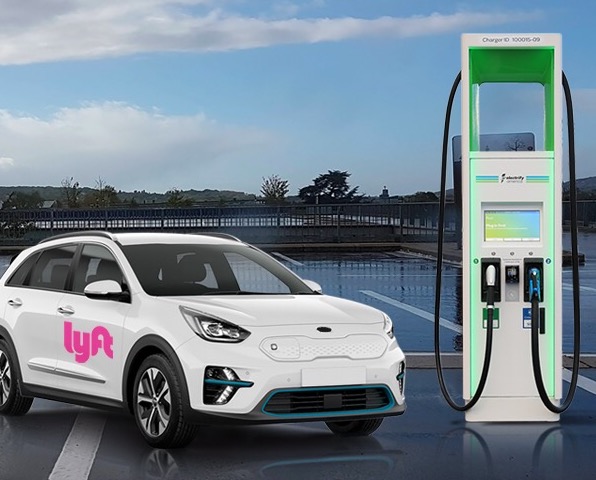
Lyft
Electrifying ride-hailing will be tricky, given most ride-hailing drivers own their own vehicles. But this summer, ride-hailing giant Lyft announced it plans to transition to 100 percent electric vehicles — both for the vehicles it owns and driver-owned vehicles — by 2030.
It’ll take a big lift, a lot of outside-the-box thinking and major policy support to get there. But the time is now, and Uber set a similar goal after Lyft.
Some policies are moving the ride-hailing giants in that direction. Cities, many of them in Europe, are setting incentives and mandates to ban fossil-fuel vehicles and transition to zero-emission vehicles in city centers. States such as California are setting specific rules for the ride-hailing companies to track and reduce their emissions.

City of Oakland
The city of Oakland in California has a long history of setting climate and sustainability goals, and in 2003 adopted a green fleet policy. As a result of a holistic and innovative approach, the city — which uses 1,500 types of vehicles — no longer uses diesel-powered vehicles and is using a combination of low-carbon fuels, compressed natural gas and electric vehicles.
Its circular renewable diesel fueling system is unique in the country. It takes waste grease and oils from local businesses and its partner Neste converts them to renewable diesel, which then powers many of Oakland’s trucks. Richard Battersby, assistant director at Oakland Public Works, is a leader in the green fleet space for his work on Oakland’s fleet.
This summer, Oakland adopted an equitable climate plan with ambitious targets for 2030, calling for a 60 percent reduction in greenhouse gases relative to 2005 levels. The end goal is carbon neutrality.

PG&E
Northern California’s Pacific Gas & Electric (PG&E) has spent the last few years building out an electric fleet of 1,360 electric vehicles to add to the thousands of other vehicles in its low-carbon fleet that use sources such as natural gas and biodiesel. The company uses vehicles such as pickup trucks, bucket trucks and light-duty vehicles for various operations.
PG&E’s goal is to electrify 100 percent of its light-duty vehicles, 10 percent of its medium-duty vehicles and 5 percent of its heavy-duty vehicles. There are particular challenges with battery range when it comes to electrifying heavy-duty emergency response vehicles and other work vehicles that don’t have unpredictable and lengthy routes.
In addition to transforming its own fleet, PG&E is supporting the uptake of EVs for its 23,000 employees and has installed more than 1,230 charging stations at its facilities. It makes sense for utilities to be early adopters of fleet electrification, given they are helping their customers make a similar transition and need to learn their customers’ experience.

PepsiCo
Global beverage behemoth PepsiCo has an overarching goal to reduce its total greenhouse gas emissions by 20 percent by 2030. It’s got a lot of work to do across packaging, water, the sources for its products and — its fleet. The company runs vehicles such as long-haul trucks, yard trucks and forklifts to move its various products — from soft drinks to snacks to bottled water — across the globe.
PepsiCo is building out a pilot facility with various low-carbon and electric vehicles at its Frito Lay campus in Modesto, California. The site, leveraging state incentives, will use 15 electric Tesla Semi Trucks, six electric Peterbilt e220 straight trucks, three BYD electric yard trucks, 12 BYD electric forklifts and 38 Volvo natural gas trucks fueled by renewable natural gas. The facility also will deploy charging and fueling infrastructure as well as solar and onsite battery storage.

Portland General Electric
In September, Portland-based utility Portland General Electric announced that it plans to electrify large portions of its 1,167 vehicles. It already has 91 EVs in use, but the new commitment will deploy 600 electric vehicles and retire 600 fossil fuel-burning vehicles over the next 10 years.
The goal is for its fleet to be 61 percent electric within a decade. Like with Pacific Gas & Electric, the really heavy-duty trucks — bucket trucks and dump trucks — will be the hardest to electrify, and Portland General Electric plans to transition 30 percent of those.
Beyond fleet electrification, Portland General Electric has been a leader when it comes to trying to proactively find ways to enable the EVs on its network to be a net benefit. It’s been building out smart grid tech and testing out a virtual power plant. The company’s electric vehicles go hand-in-hand with its clean energy goals, and Portland General Electric expects to serve half of its customers with renewable-generated electricity by 2022.

Port Authority New York and New Jersey
Port Authority New York and New Jersey has the largest electric bus fleet on the East Coast, including 36 buses and 19 chargers, at the region’s three biggest airports. The organization recently said it had reached its goal to have a 100 percent electric bus fleet by the end of this year (close to three months early).
Beyond the bus fleet, 130 of the organization’s light-duty vehicles, used by employees and police officers, are electric. By 2023, Port Authority says over 600 — or 50 percent of its light-duty fleet — will be electric.
Port Authority’s fleet goals are all part of its overarching plan to reach a 35 percent reduction of greenhouse gas emissions by 2025 and an 80 percent reduction by 2050.

Salt River Project
Tempe, Arizona-based Salt River Project (SRP) provides electricity and power to 1 million residents in central Arizona. The company has spent the past six years investigating and piloting electric vehicle tech for its employees, its fleet and its customers.
Today, SRP uses close to 200 electric vehicles, both on-road and offroad, including light-duty vehicles, bucket trucks, forklifts and utility carts. The organization also has the largest workplace EV charging program in Arizona, with close to 200 employees driving plug-in vehicles to SRP’s facility. SRP says this program is expected to grow to 450 employees (or 7 percent of its workforce) over the next five years.
Down the road, SRP’s goals are to electrify 100 percent of its sedan fleet by the end of 2021 and reduce 30 percent of its fleet emissions by 2035. In addition, SRP expects 500,000 customers using EVs by 2035, and it will build plans and programs to help charge 90 percent of those customers’ EV loads.

Santa Clara Valley Transit Authority
The Santa Clara Valley Transit Authority, which provides buses, light rail, paratransit and BART stations for greater Silicon Valley, has been an early transit group to codify sustainability goals, to implement clean energy technologies and, two years ago, to deploy electric buses.
In 2018, VTA put its first five electric buses, built by Proterra and using DC fast charging infrastructure made by Chargepoint, into service. The company has plans to procure 35 more electric buses over the next several years, on its way to meeting California’s mandate that says all transit buses must be zero-emission by 2040.
VTA closely tracks its energy use for its fleet. Its goals are to reduce its fleet’s energy consumption by 35 percent below 2009 levels by 2025 and 60 percent by 2040.

Schneider Electric
Earlier this year, energy company Schneider Electric announced that it’s joining the Climate Group’s EV100 program and will transition its entire 14,000 vehicle fleet to electric by 2030. The company is based in France but has operations across the globe.
The company sells EV charging equipment and software, among many other energy and grid products, so it makes sense for it to use this huge commitment to learn more about what its customers are experiencing. Schneider Electric is also installing EV charging equipment at its facilities for its employees.

City of Seattle
Over the last decade, the greater Puget Sound region has been looking to reduce its carbon emissions from transportation, which accounts for 60 percent of its total emissions. Alongside that regional issue, the city of Seattle has an aggressive and multi-pronged green fleet strategy for its over 6,000 vehicles, across departments such as police, fire and utilities.
Seattle’s future fleet goals include cutting greenhouse gas emissions in half by 2025 and using only fossil-fuel-free vehicles by 2030. The fleet team, led by Philip Saunders, is looking to rapidly electrify, build out EV charging infrastructure, aggressively reduce fuel use, swap in low-carbon fuels for certain types of vehicles and pilot technologies that are not yet cost-effective or widely available.
The company uses a wide range of technologies including renewable diesel, biodiesel, propane and EVs.

Twin Rivers School District
Three years ago, Twin Rivers School District in California became one of the first school districts in the U.S. to deploy electric school buses. Today the organization operates 35 electric school buses, and over the next three years it plans to convert the bulk of its fleet, or 91 school buses, to electric.
In the interim, Twin Rivers has natural gas buses, some of which run on renewable natural gas, and is running all of its diesel buses on renewable diesel from Neste. Following the switch to renewable diesel, it’s entire fleet is fossil-fuel-free.
Twin Rivers Director of Transportation Tim Shannon told GreenBiz in an interview earlier this year that the organization is already using the electric buses to pilot the vehicle-to-grid technology with Sacramento Municipal Utility District. It’s not just about cool tech, though. Shannon explains: “Our green bus program is taking an area that is highly densely populated, we’re transporting a lot of kids, we’re a disadvantaged community and a high rate of air pollution. We’re lowering all that, and we’re making it an eco-friendly place to live.”

Uber
Following Lyft’s announcement, Uber revealed that it, too, plans to transition to an all zero-emission fleet. Uber says it will reach that goal by 2040. First, it will have 100 percent of its rides in the U.S., Canada and Europe, be electric by 2030.
Uber already has made progress in cities such as London, where it’s moving to an all-electric fleet. Uber says it will commit $800 million to help drivers on its platform move to EVs by 2025. The company also operates scooters and bikes, and its app encourages riders to use public transit.
The ride-hailing giants need to move to ZEV as cities and states pressure them with mandates. The California Air Resources Board recently found that the carbon emissions of Uber and Lyft’s vehicle fleet per passenger mile is over 50 percent higher than regular cars driving on the roads.

Unilever
The consumer product company, based in the United Kingdom and the Netherlands, says it will commit its entire global fleet of 11,000 vehicles to electric by 2030 as part of the Climate Group’s EV100 program. Its interim goals are 25 percent EV or hybrid by 2020, and 50 percent by 2025.
Unilever has broader sustainability goals beyond its fleet, which include becoming “carbon positive” in its operations by 2030; 100 percent of its energy will come from renewables.

UPS
For several years UPS has been operating its “rolling laboratory” approach to piloting and deploying low-carbon and electric vehicles. Of its fleet of 125,000 package vans, trucks, motorcycles and tractors, UPS has 10,300 alternative-fuels vehicles, and it’s done a substantial project in London with smart grid tech and EVs.
Earlier this year, UPS kicked its EV plans into overdrive. UPS announced it plans to buy 10,000 electric vehicles from partner Arrival, purpose-built for UPS. At the same time, UPS made an investment in the startup through its venture arm, UPS Ventures.
The strategy is similar to Amazon’s move with Rivian. The OEMs haven’t been producing the vehicles that these large fleets want and need, so the biggest companies are diving into the supply chain to help create their own.

Wow, this article is nice, my younger sister is analyzing such things, thus I am going to
convey her.
I got what you intend, appreciate it for putting up.
Woh I am pleased to find this website through google.
Take a look at my website :: Keto Complete Diet
Hi! I just wanted to ask if you ever have any issues
with hackers? My last blog (wordpress) was hacked and I ended up losing
several weeks of hard work due to no backup. Do you have any methods to stop hackers?
Also visit my blog :: Testo Bull Reviews
Hello! I’ve been following your blog for a while now and finally got
the bravery to go ahead and give you a shout out
from Kingwood Texas! Just wanted to tell you keep up the excellent job!
Check out my page – 800ws.net
What’s up, after reading this amazing article i am
too glad to share my experience here with colleagues.
Stop by my site; IQ SuperCharged Reviews
I am lucky that I detected this web site, just the right information that
I was searching for!
Feel free to visit my web page Maximum Recall Ingredients
I really like reading and I believe this website got some really useful
stuff on it!
Also visit my web site :: Green Flame CBD Reviews
Nice read, I just passed this onto a colleague who was doing some research on that.
And he actually bought me lunch since I found it for him smile So let me rephrase that: Thanks for lunch!
Here is my web-site Amellia Anti Aging Cream
Rattling instructive and fantastic body structure of subject material, now that’s user friendly (:.
Also visit my web page – Virectin Reviews
Hello.This post was really interesting, especially because I was looking for thoughts on this issue last Wednesday.
Also visit my web blog: http://www.klnjudo.com
Right now it seems like WordPress is the top blogging platform out there right now.
(from what I’ve read) Is that what you’re using on your blog?
Stop by my web site Spore Mens Vitality Mix Reviews
Hi, Neat post. There’s an issue along with your website in web
explorer, may test this? IE still is the marketplace chief and
a big component to other folks will omit your fantastic writing due
to this problem.
My web site Hydra Riche Reviews
Outstanding post, you have pointed out some great details,
I also think this is a very wonderful website.
Also visit my site :: Kathryn
Real informative and great structure of articles, now that’s user friendly (:
.
my web blog; Amellia Cream Review
I carry on listening to the news talk about receiving boundless online grant applications so I have been looking around
for the finest site to get one. Could you tell me please,
where could i get some?
My page DFine8
Hello this is somewhat of off topic but I was wondering if blogs use WYSIWYG editors or
if you have to manually code with HTML. I’m starting a blog soon but have no coding
skills so I wanted to get guidance from someone with experience.
Any help would be enormously appreciated!
my web page: Erexzen
This article is actually a nice one it helps new web people, who are wishing in favor of blogging.
Also visit my web page :: Pure Remedy CBD Review
I am so happy to read this. This is the type of manual that needs to be given and not
the random misinformation that’s at the other blogs.
Appreciate your sharing this greatest doc.
Check out my homepage; Sion Air Cooler
I rarely drop responses, but I glanced through some remarks on The top 25 most sustainable fleets
– ecoShuttle Charter & Tours. I actually do have a couple of
questions for you if it’s allright. Is it just me
or do a few of the remarks appear as if they are left by brain dead visitors?
😛 And, if you are posting on additional online social sites, I would like to follow anything fresh you
have to post. Could you post a list of all of your
shared sites like your twitter feed, Facebook page or linkedin profile?
Also visit my web-site … Syner Sooth CBD
Yeah bookmaking this wasn’t a bad determination outstanding post!
Review my site; Dermal Pearle Ageless Moisturizer
Very interesting info!Perfect just what I was looking for!
Feel free to surf to my site :: IQ SuperCharged
I’m really impressed with your writing skills as well as with the layout on your weblog.
Is this a paid theme or did you modify it yourself? Anyway keep up the
nice quality writing, it is rare to see a nice blog like this one today.
my page … librarius.main.jp
Yeah bookmaking this wasn’t a bad conclusion great post!
My blog post Oracle Leaf CBD
I couldn?t refrain from commenting. Perfectly written!
Here is my site :: Rae
Tremendous things here. I’m very satisfied to look
your post. Thank you a lot and I am taking a look ahead to contact you.
Will you kindly drop me a mail?
my homepage: lysto-forum.tue-image.nl
Just wish to say your article is as astonishing. The
clearness to your post is simply excellent and
that i could think you are an expert in this subject.
Fine along with your permission allow me to seize your RSS
feed to keep updated with approaching post. Thank you a million and please continue the gratifying
work.
My page :: librarius.main.jp
Hello, I read your blogs daily. Your story-telling style is awesome, keep
up the good work!
Visit my blog post :: Sion Air Conditioner
You have noted very interesting points! ps decent website.
Feel free to surf to my page … Green Flame CBD Gummies Review
You really make it appear so easy together with your presentation but I in finding this matter to be really something
which I think I would never understand. It kind of feels too
complicated and extremely extensive for me. I am taking a look ahead to your subsequent submit,
I will attempt to get the dangle of it!
My web blog – WifiLift Cost
Good day! Would you mind if I share your blog with my myspace group?
There’s a lot of people that I think would really enjoy your content.
Please let me know. Many thanks
Check out my website – http://www.koan.at
I know this if off topic but I’m looking into starting my own blog and was curious what all
is required to get set up? I’m assuming having a blog like
yours would cost a pretty penny? I’m not very internet smart so I’m not 100% positive.
Any suggestions or advice would be greatly appreciated.
Many thanks
My page; SlimX Keto
Hi there great blog! Does running a blog similar to this require a large amount of
work? I’ve absolutely no expertise in programming but I had been hoping to start my own blog
soon. Anyway, if you have any recommendations or tips for new
blog owners please share. I understand this is off topic however I just needed to ask.
Cheers!
Also visit my web site … Slimy Vita Vital Effect
Great post. I was checking continuously this blog and I am impressed!
Very helpful info specifically the last part 🙂 I care for such information a
lot. I was looking for this particular information for a very
long time. Thank you and good luck.
My homepage – Oracle Leaf Gold CBD Oil
Thank you for sharing with us, I believe this website truly stands out
:D.
Feel free to surf to my webpage – Fast Dash Keto Ingredients
I dugg some of you post as I cogitated they were very
useful handy.
Take a look at my webpage … VigraFast Review
Yeah bookmaking this wasn’t a bad decision great post!
Also visit my webpage … SynerSooth CBD
My coder is trying to persuade me to move to .net from PHP.
I have always disliked the idea because of the expenses. But he’s
tryiong none the less. I’ve been using WordPress on a variety of websites for about a year and am nervous about switching
to another platform. I have heard great things about blogengine.net.
Is there a way I can import all my wordpress posts into it?
Any help would be greatly appreciated!
Feel free to surf to my web site … librarius.main.jp
Very good website you have here but I was wondering if you knew of any community forums
that cover the same topics talked about here?
I’d really love to be a part of community where I can get advice from other experienced individuals that share the same interest.
If you have any recommendations, please let me know. Cheers!
my page Nutri Blendx Rapid Keto Cut
Wow, superb blog format! How long have you ever been running a
blog for? you make running a blog look easy. The overall glance of your website is great,
as neatly as the content material!
Also visit my blog post – Advanced CBD
This piece of writing provides clear idea designed for the new people of blogging, that in fact how to do blogging.
Also visit my web page DFine8
What’s up Dear, are you really visiting this website regularly, if
so then you will absolutely get good experience.
Also visit my web page 163.30.42.16
Hello! Do you use Twitter? I’d like to follow you if that would be ok.
I’m definitely enjoying your blog and look forward to
new updates.
Here is my web site :: WifiLift
Do you mind if I quote a few of your articles as long as I provide credit and sources back
to your webpage? My blog is in the very same area of interest as yours
and my visitors would definitely benefit
from some of the information you present here. Please let me know
if this alright with you. Appreciate it!
What i don’t realize is in truth how you are not really a lot more
smartly-preferred than you might be right now. You are very intelligent.
You know thus considerably in terms of this topic,
produced me personally imagine it from numerous varied angles.
Its like men and women are not involved except it is something to do with Lady gaga!
Your own stuffs excellent. At all times handle it up!
Also visit my page; Evo Naturals Hemp Gummy Bears Reviews
I like reading through an article that can make men and women think.
Also, thanks for allowing me to comment!
Tremendous things here. I’m very satisfied to peer your post.
Thanks so much and I am looking forward to contact you.
Will you please drop me a mail?
Marvelous, what a blog it is! This website gives valuable information to us, keep it
up.
Thanks to my father who shared with me regarding this webpage, this web site is in fact remarkable.
Wonderful blog! I found it while searching on Yahoo News.
Do you have any tips on how to get listed in Yahoo News?
I’ve been trying for a while but I never seem to get there!
Many thanks
I don’t know whether it’s just me or if everyone else encountering problems with your blog.
It appears like some of the text within your content are running off the screen. Can somebody else please provide
feedback and let me know if this is happening to them too?
This could be a issue with my web browser because I’ve
had this happen before. Cheers
WOW just what I was searching for. Came here by searching for website
hello!,I like your writing very so much! percentage we keep in touch more
about your post on AOL? I need an expert on this area to resolve my problem.
May be that’s you! Having a look forward to peer you.
Feel free to visit my blog post :: forum.adm-tolka.ru
Excellent post. I was checking constantly this blog and I’m impressed!
Very useful info specifically the last part 🙂 I care for such
info much. I was looking for this certain information for a long time.
Thank you and best of luck.
Also visit my webpage – Wawza Gummies
Hey just wanted to give you a quick heads up.
The text in your article seem to be running off the screen in Firefox.
I’m not sure if this is a format issue or something to do with internet browser compatibility but I thought I’d post to
let you know. The design and style look great though!
Hope you get the problem resolved soon. Kudos
Look at my web site :: Bryant
Wonderful work! That is the kind of information that are supposed to be shared across the net.
Shame on the search engines for no longer positioning this
post upper! Come on over and consult with my web site .
Thanks =)
My web page; VigorMax Male Enhancement
Hey there! Do you know if they make any plugins to protect
against hackers? I’m kinda paranoid about
losing everything I’ve worked hard on. Any tips?
My web site: BioShed Keto Slim
Hello.This article was extremely motivating, especially because I was looking for
thoughts on this matter last Sunday.
Also visit my web blog; Vinyasa Organics Review
Thanks for every other informative site. Where else could
I am getting that kind of information written in such a perfect means?
I have a venture that I am simply now working on, and I have been on the look out for such
information.
Here is my website; Leonore
Wonderful items from you, man. I’ve take note your stuff previous to and you are just extremely great.
I really like what you have obtained right here, certainly like what you’re saying and the way in which
during which you are saying it. You make it enjoyable and
you continue to care for to stay it smart. I can not wait to learn far more from you.
This is actually a wonderful web site.
my site; VikingXL Keto
I am in fact delighted to read this weblog posts which consists
of lots of valuable facts, thanks for providing such
statistics.
Also visit my web site :: Moscatcher
I am no longer certain the place you’re getting your information, but
great topic. I needs to spend a while finding out more or working out
more. Thanks for magnificent info I used to be in search of this information for my mission.
My web site Erorectin Ingredients
It?s nearly impossible to find well-informed people on this topic,
but you seem like you know what you?re talking about!
Thanks
my blog :: NeoPodz
If some one desires to be updated with latest technologies therefore he must be
visit this web page and be up to date daily.
My web blog; Summer Valley CBD Gummies Review
Everyone loves what you guys are usually up too.
Such clever work and exposure! Keep up the very good works guys I’ve
added you guys to my own blogroll.
Look at my webpage :: Hydrofirm Review
Undeniably believe that which you said. Your favourite justification seemed to be at the net the easiest thing to take note of.
I say to you, I definitely get irked at the same time as other
people consider concerns that they plainly don’t realize about.
You controlled to hit the nail upon the top and also outlined out the entire thing with no need side effect
, people could take a signal. Will likely be back to get more.
Thank you
Tremendous things here. I am very glad to see your article.
Thank you so much and I’m looking ahead to contact you.
Will you kindly drop me a e-mail?
Also visit my web blog; Neo Bio Keto Reviews
This design is steller! You certainly know how to keep a reader entertained.
Between your wit and your videos, I was almost moved to start
my own blog (well, almost…HaHa!) Wonderful job. I really loved what you had to say,
and more than that, how you presented it. Too cool!
Feel free to surf to my web blog WifiLift
Hello friends, its fantastic post on the topic of educationand completely explained, keep it up
all the time.
My web blog; Oracle Leaf Gold CBD Review
Hello i am kavin, its my first time to commenting anyplace, when i read this piece of writing i
thought i could also make comment due to this sensible post.
my homepage; Testo Bull Capsules
I like the helpful information you provide in your articles.
I’ll bookmark your blog and check again here frequently.
I am quite sure I will learn a lot of new stuff right here!
Best of luck for the next!
Also visit my web-site :: MosQiller S Reviews
I am lucky that I found this website, precisely the right information that
I was searching for!
my web blog Maximum Recall Ingredients
This page certainly has all of the info I needed about this subject and didn?t know who to ask.
Feel free to surf to my blog – Green Flame CBD Review
always i used to read smaller content which as well clear
their motive, and that is also happening with this paragraph which I
am reading at this place.
Check out my homepage; http://forum.m2clasic.ro/
I don’t normally comment but I gotta say appreciate it for the post on this
special one :D.
Also visit my web page – MosQiller S Review
This is very attention-grabbing, You’re an excessively
skilled blogger. I have joined your feed and look forward to in the hunt for more of your great post.
Also, I have shared your website in my social networks
my web-site – Bio Wellness CBD Gummies Price